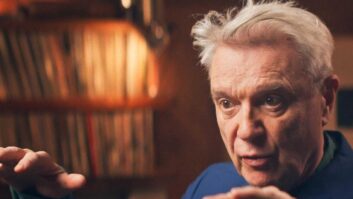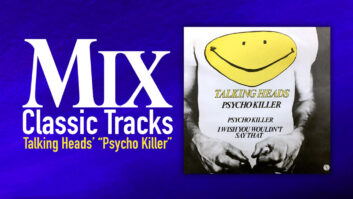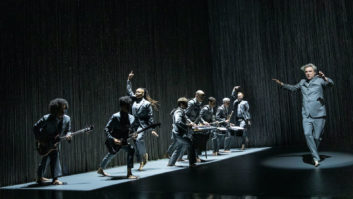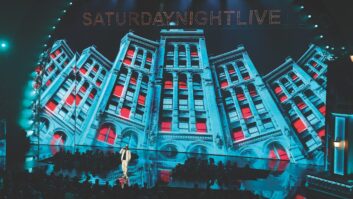David Byrne is on tour to promote Look Into the Eyeball, his latest CD, and will be playing around the U.S. and Europe until at least the end of the year. Traveling light, with only an in-ear monitor system and FOH racks, the tour is picking up sound production and a string section locally. Seen here at San Francisco’s famous Fillmore Auditorium in June, Byrne’s lively show includes new and familiar material from his solo catalog, as well as a few Talking Heads favorites.
George Bade oversees David Byrne’s guitar setup. “It’s basically three separate little rigs,” he says. The Guild acoustic contains a custom preamp that plugs into a tube DI. The electric rig includes a Gretsch Chet Atkins run through a pedal board, including an MXR Micro amp, an old Ibanez Autowah and a Sans Amp, “which has a real nice overdrive,” and then into a reissue Vox AC-30 set offstage. Byrne’s third axe is a Godin, which is strung with nylon classical guitar strings and features a MIDI output in addition to a standard pickup. The Godin’s MIDI output is fed to a Roland GR-1, which, in turn, outputs both a “straight acoustic tone” and synth sounds.
Appearing with David Byrne on tour are Paul Frazier (bass), David Hilliard (drums) and Mauro Refosco (percussion). Supplementing the group at the Fillmore were San Francisco Symphony and San Francisco Opera Orchestra members Melissa Kleinbart, Naomi Kazama and Cathy Down (violins), Adam Smyla (viola), and Peter Wyrick and Nora Pirquet (cello).
Monitor engineer Kris Umezawa is on his second tour with Byrne, who is using in-ear monitors (IEMs). “David’s had in-ears for a while now,” says Umezawa. “They’re great from a mixing standpoint, as it’s a quiet and clean stage.” Umezawa is mixing on a Mackie digital 8-bus supplemented with two Mackie 1604s that are used only for their mic pre’s. “I’ve got 40 analog inputs with 38 mic pre’s,” explains Umezawa. “It’s a pretty sleek package.”
Like Mann, Umezawa finds that working with new string players in every city is quite a challenge. Though the players are almost always top-notch, many of the musicians have not used IEMs before and are understandably apprehensive about having mics hooked onto their valuable instruments.
FOH engineer/tour manager David Mann has worked with Herbie Hancock, Don Was, Luna, Lloyd Cole and Duncan Sheik, among others. Mann’s FOH rack includes BSS DPR-402s and an Eventide Harmonizer for Byrne’s vocal, and dbx166 compressors for drums. “When I go to Europe, I’ll have a rack of BSS 402s, some Drawmer gates, an Eventide 3000 and a Meyer CP-10 Parametric Equalizer, which I’ll use on the cellos,” he notes. Mann is using primarily Music Valve Electronics Tube DIs, but he selected a Demeter tube DI for Byrne’s guitar setup.
The tour is endorsing Shure microphones, and Mann has selected FX185 lavalier mics for the violins and violas. “I’m doing a lot of creative EQ’ing as well,” explains Mann. “The lav mics, because they’re designed for speech, are a little hot around 3 kHz. When you roll that off, you get a very warm sound on the strings, plus you attenuate a lot of the leakage from all the percussion instruments.” On the cellos, Mann cuts “just about everything but 2.5 kHz. You get the sound of the bow and the rosin sound, which gives the timbre of the cellos. That cuts through the mix — it really works.”







